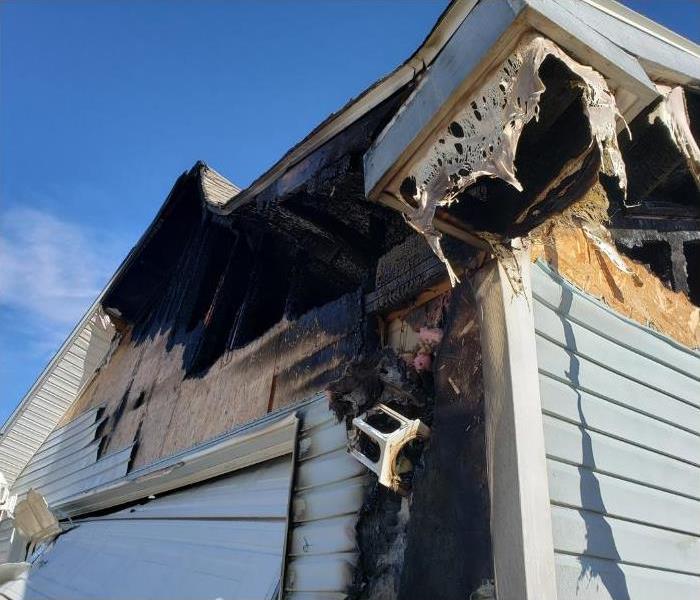After a Fire: Essential Clean-Up Services
5/22/2023 (Permalink)
A house fire is the stuff of our nightmares. They can cause injury and damage in the blink of an eye. After a minor fire, homeowners can clean up a little without special equipment. A few household cleaning products and sponges clean some soot and residue left by a fire extinguisher and can usually tackle a small mess. SERVPRO® of South Nashville offers everything you need for a cleanup after a fire.
But the aftermath of all other fires demands professional fire damage cleaning and fire damage repair. This is necessary because of the extent of the water damage, which can lead to black mold and the rotting of materials like drywall and wood. Additionally, odors penetrate deeply into almost any item and can linger permanently if not addressed. We can help with all fire damage needs.
What’s Involved in Fire Damage Restoration
Generally, a fire damage restoration service must perform odor removal, water damage remediation, and smoke and soot removal. Their services depend on how serious and extensive the fire was. In severe cases, part of the structure will have to be removed and replaced. Damaged flooring and windows, for example, would have to be pulled out and replaced. Shingles or roofing tiles will need replacing. Fires where the fire department must deploy a firehose, will need special expertise.
Water Damage Restoration
Our specific steps to remediate water damage after a house fire depends on the damage's extent and the fire's particular circumstances. However, the steps in the process look like this:
- Assess the damage: This process may include testing the moisture levels in affected areas, as well as visually inspecting walls, ceilings, and floors for signs of water damage.
- Remove standing water: This must be done quickly to prevent further damage, especially to wood and other porous materials. Water removal may involve using pumps, wet vacuums, and other drying equipment.
- Dry out the affected areas: Removing standing water is only one-half of the drying process. Mold can start to grow on a damp surface in 24 to 48 hours. The fire damage clean-up service may use dehumidifiers or fans to reduce moisture levels in the air and extract moisture from surfaces in the affected area. Damaged flooring, drywall, and furniture will also need to be removed.
- Clean and sanitize: When the affected area has been cleaned up and dried out, the fire damage restoration service can begin to clean and sanitize the area to keep mold and mildew at bay.
- Restore the property: The last step is to repair or replace damaged materials, repaint the walls, redo textured ceilings, and otherwise return the damaged area to its original condition.
The exact process a fire damage remediation company uses will depend very much on the specific situation. However, it is almost always best to handle water and other damage by professionals.
Odor Control
Fire damage restoration contractors could use various techniques to remove the odors left behind after a house fire. These are the standard methods:
- Air scrubbers: Air scrubbers use HEPA (high-efficiency particulate air) filters to trap particles as small as 0.3 microns, including smoke, soot, dust, and mold spores.
- Ozone generators: An ozone generator uses highly reactive ozone molecules to break down the molecules that produce unpleasant odors.
- Thermal fogging: A machine produces a fine mist of deodorizing solution that is heated and dispersed throughout the affected area. The mist penetrates porous materials and neutralizes odors that ordinarily defy easy removal.
- Hydroxyl generators: These devices produce highly reactive hydroxyl molecules to eliminate odors. These devices are safe to use in occupied areas and may be used continuously to control odors.
A fire damage restoration company might also clean and deodorize surfaces to remove any remaining odor-causing particles.
As with water damage, the specific method or methods that a clean-up calls for will depend on the situation. The extent of damage and the location of the damage will dictate what exact processes need to be used. A fire damage restoration company will evaluate the situation and develop a customized plan to effectively remove odors and restore the property to its pre-fire condition.
Smoke and Soot Removal
Smoke will tend to penetrate every porous surface in the area and stick to any solid surface in the affected rooms. Cleaning this soot can take some specialized equipment and techniques. A fire damage restoration company may use one or more of these methods to clean up the soot and smoke damage in your home:
- Use vacuums or dry-cleaning sponges to clean non-porous surfaces.
- Employ specialized cleaning solutions and equipment to remove residues from hard surfaces and fabrics.
- Run a HEPA filter vacuum over upholstery and carpets.
- Apply baking soda to blow away soot and smoke residues.
- Use air scrubbers to filter out odors and smoke particles that linger in the air.
Getting professional help to clean up after any fire is important; the worse the damage, the more important it is to get a professionally trained and equipped clean-up crew on the scene.
Leave Post-Fire Clean-up to the Pros
Fire damage restoration is a complex process that, if not done professionally, can lead to black mold, mildew, wood rot, and lingering unpleasant odors. Avoid those risks by looking for a fire damage restoration service. After a fire, call SERVPRO of South Nashville for fire damage repair work done professionally and promptly by calling (615) 331-0200.



 24/7 Emergency Service
24/7 Emergency Service
